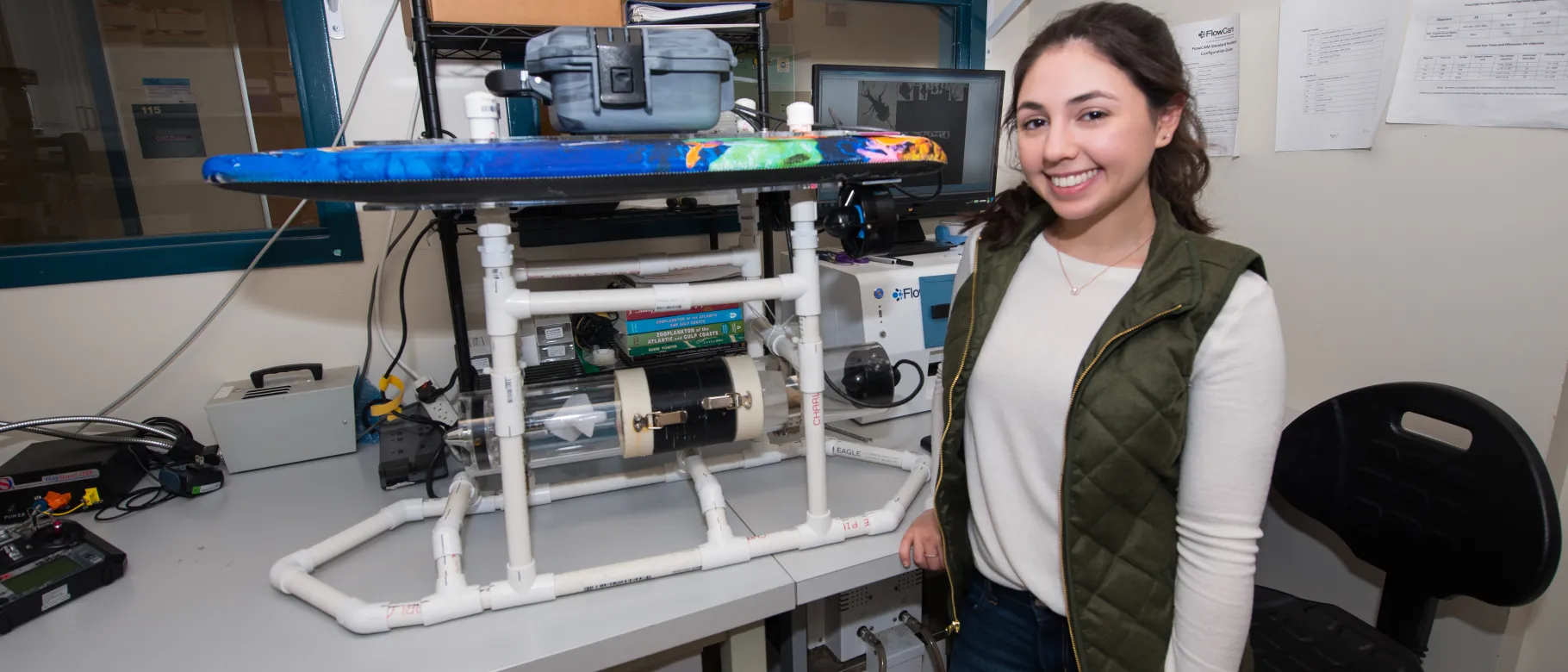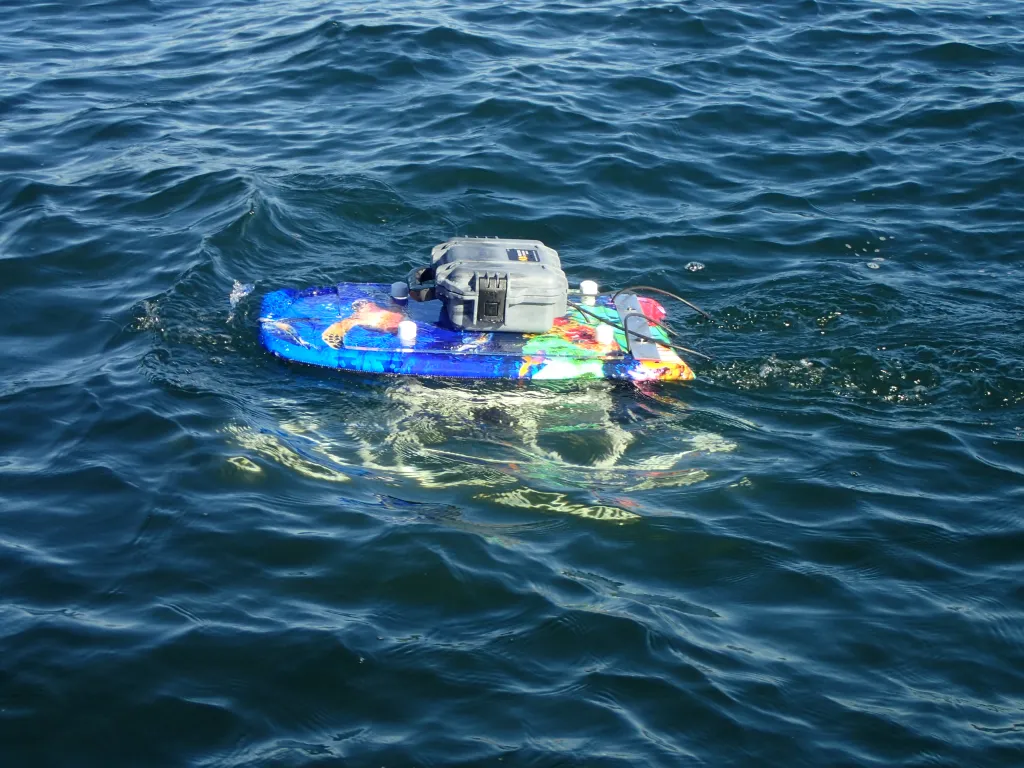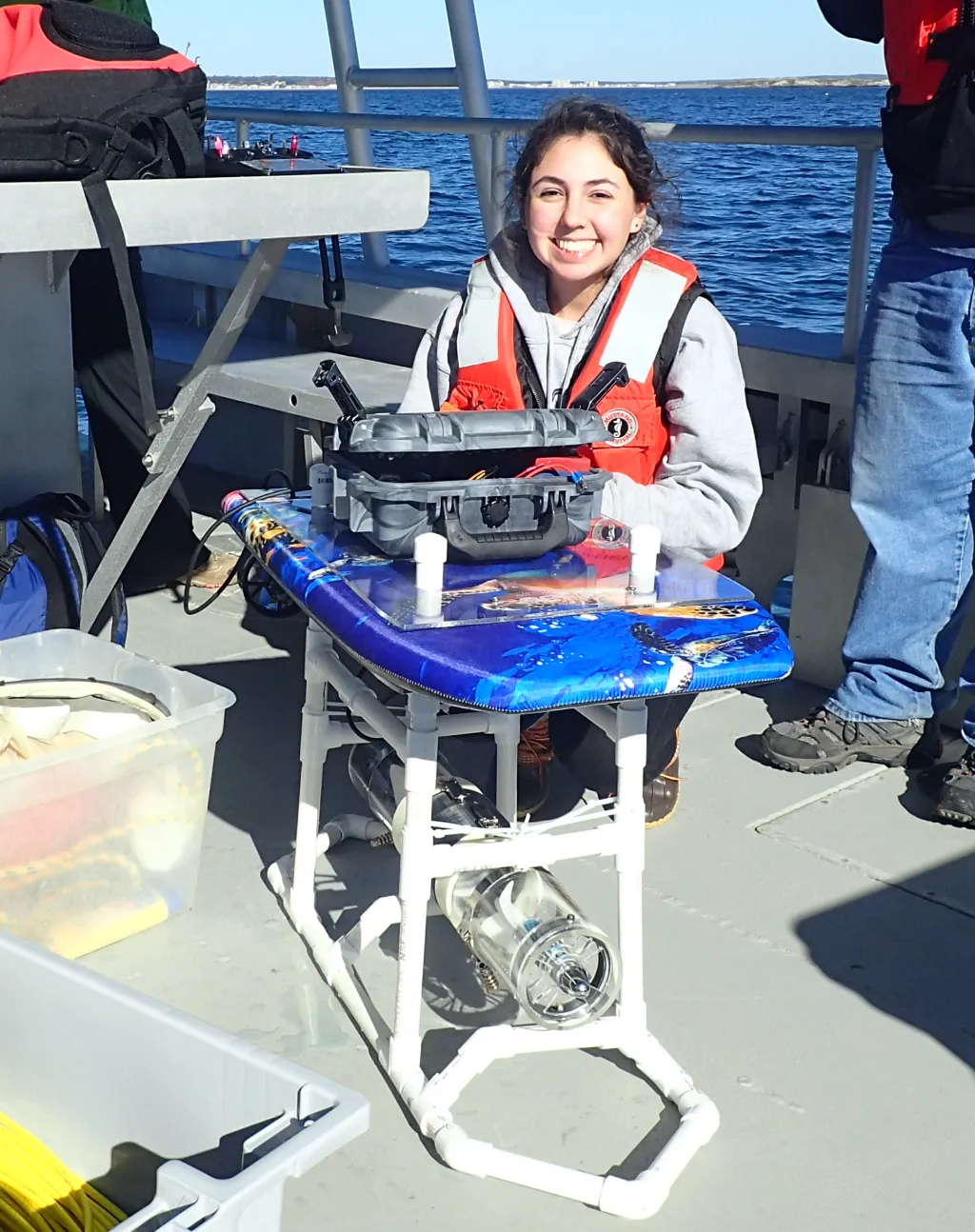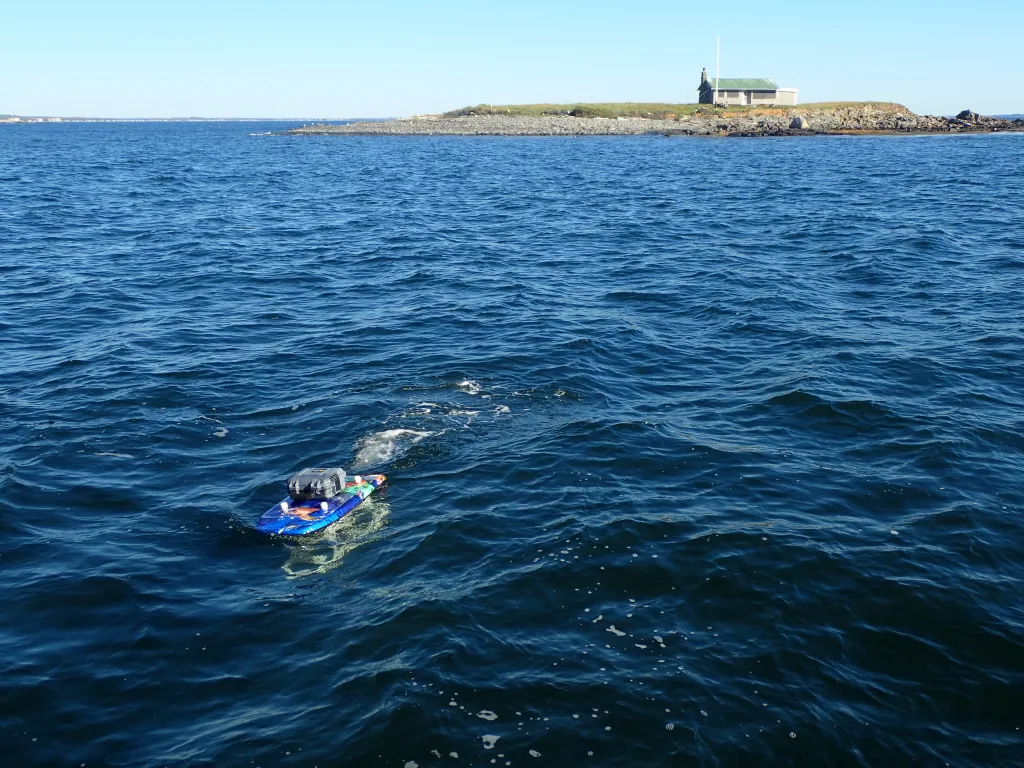The Invention of Ariella Danziger: A Marine Scientist’s Evolution

For the vast majority of us living on the coast of Maine, taking a dip in the summertime doesn’t involve pristine waters and chlorinated pools. Cooling it in the hot weather usually means a trip to our local beach and a teeth-chattering plunge into the Atlantic. Most of the time, we’re too preoccupied with the water temperature to mind the seaweed, the only living thing that we can discern in the shallow waters where we splash, and we certainly don’t pause to think about the fact that we are swimming among an abundance of organisms too small for the naked eye to see. But they are there: billions and billions of plankton, the microscopic plants and animals that float along on the tides and currents and serve as the base of the ocean’s food chain.
University of New England student Ariella Danziger doesn’t just casually think about those tiny specks of life; she’s been living and breathing plankton, metaphorically of course, for the past year. After working as a lab technician in the Arthur P. Girard Marine Science Center during her sophomore year, Danziger, a double major in Marine Sciences and Education, was asked if she would be interested in doing research in the lab of Professor Markus Frederich, Ph.D. “I was a little bit scared of it, but I definitely wanted to,” Danziger said of the offer. “I spoke to Markus, and I felt like what he wanted to study was so scary for me but so incredible,” she shared. Danziger ended up successfully applying for a Sustainable Ecological Aquaculture Network (SEANET) grant that enabled her to spend the summer between her sophomore and junior years as a research student in Frederich’s lab, which concentrates on the study of the invasive green crab, a species thriving under the altered conditions brought about by climate change -- and one that threatens to severely disrupt ecosystems as well as fishing and aquaculture industries.
These pesky green crabs don’t fall from the sky, however; and they certainly aren’t brought by storks. They start out as tiny larvae, contributing to the category of animal plankton known as zooplankton. Frederich felt that to really understand the green crab problem, it was important to not just study the adults but to study the larvae as well. “We know by now in great detail what kind of adult invasive crabs come here, when they breed, how fast they grow, and more. But we don’t know much about the larvae populations in this area,” explained Frederich. So Danziger was tasked with the research, despite some wariness on her part. “I knew that plankton was a bit out of my realm,” she admitted, “but I wanted to give it a chance, and I really wanted to work with Markus. At that point in my life, plankton was not in my head. I did not ever see myself studying plankton.”
Her affinity for zooplankton, it seems, is rooted, at least in part, in a sense of awe about the seemingly miraculous development of these organisms from tiny larvae to adult animals –a complex and multi-step process that is cloaked in the mystery of the sea. “It’s incredible, and I think that’s how I kind of fell in love with plankton – because you don’t realize how much is going on in the ocean with these organisms,” she explained. And green crab larvae do, indeed, have a lot “going on,” transforming through four zoea stages, a megalopa stage (when legs develop), and a juvenile stage before they reach adulthood.
Perhaps Danziger feels a sort of kinship to these creatures-in-progress, as her study of them has involved a great deal of growing and changing on her part. Even the process of realizing that she wanted to go into a marine science field entailed an evolution. For years, her mind was set on becoming an archeologist, and then she dabbled with the idea of marine archeology. But taking a step outside of her comfort zone as an eighth-grader to participate in a whale camp run by Johns Hopkins University’s Center for Talented Youth (CTY) program made her recognize that archeology wasn’t in her blood at all. “It was probably one of the most amazing things I ever did,” she said of the camp, “and it kind of solidified the whole idea of me going into marine … because we learned so much about the whales in the sea and evolution and all other different marine organisms and how they interact … After that, I kind of looked into a marine career more, and I just knew that that was what I wanted to do.” The camp was a bit of a frightening experience for Danziger at the time, as two weeks of the program were spent living on a boat – a prospect that she described as “kind of scary.” Fortunately for her, the experience was overwhelmingly positive and set a precedent: it was the first of many times that taking a risk would change her in way that significantly altered the course of her life.
“I remember the first time I found jelly fish larvae, and I wanted to cry.”
And deciding to do plankton research under Frederich was one such time. “This was completely different than anything I had ever done before,” she said of the work required of her. And when Frederich explained to her what, precisely, he wanted her to focus on, Danziger’s anxiety grew.
In order to study zooplankton, it is, of course, necessary to obtain samples, but this is not as easy as it sounds. While many researchers use plankton nets to capture their specimens, sometimes an area’s unique conditions are not conducive to the use of nets. The first step in netting plankton is to locate it. Because tides and currents are necessary for the survival of zooplankton (which are not capable of swimming and, therefore, rely on the movement of water to travel), areas with strong currents are likely places to find specimens. One site targeted for collection by Frederich and Danziger was a place slightly beyond “the gut” (the area where the river and the ocean meet), which has a strong current. But the water there was too deep to wade through with a net. The research pair then attempted to kayak to an area off the old Biddeford Pool coast guard station, but that area proved too shallow, and the net scraped along the ocean floor, stirring up algae, rocks, and other ocean debris that clogged the net. The solution? A device that could be dispatched to any desired location to collect ocean water and filter the zooplankton for study. And Danziger was tasked with the creation of such a device – a prospect that “terrified” her.
She was introduced to UNE’s Makerspace, a laboratory for creation and building, where she would go to work for the next 12 months, both designing and actually constructing a prototype. Despite her fears, Danziger opened herself up to the challenge. “It was something very new for me,” she said. “It’s very hard for me to get out of my little bubble of protection, but it sounded amazing, so it was the perfect opportunity.”
“It’s incredible, and I think that’s how I kind of fell in love with plankton – because you don’t realize how much is going on in the ocean with these organisms.”
Initially, being in the Makerspace was tough for Danziger, who felt “overwhelmed” … because [she] had “never really made anything before.”
“I used to do work with Habitat for Humanity, so I could hammer, and that was the extent of it,” she laughed. “So going in there was very new, and I was very scared. I didn’t know anyone who was there.” Her feeling of being lost at sea did not last long, however. She quickly received support and help from Mike Esty, Makerspace technician and project specialist, Tony Santella, Makerspace program coordinator, and several other students who had experience in the Makerspace – students whom she had never before met but whom she counts among good friends today.
Through a great deal of trial and error, Danziger fashioned a prototype of what is now affectionately known as “the sucker.” Made of a boogie board, PVC piping, thrusters, acrylic tubes, removable plankton netting, and a remote control component, the device acts as a buoyant vacuum system that sucks plankton into a filter. While two thrusters control the movement of the device, another one pulls in water, which passes through a flow meter, thereby enabling the researchers to gauge how much water the device has taken in. The water then flows through acrylic tubes, which house a plankton filter whose holes are just the right size to capture zooplankton. The tubes, connected by a piece of plastic that Danziger created using the Makerspace’s 3D printer, can be unlatched from one another, allowing access to the removable filter. The electronic components of the remote control float above the water, atop the boogie board, while the system of PVC piping gives structure to the device. Danziger said that the prototype required innumerable tweaks, one important one being the extension of the PVC piping below the device to serve as a guard rail in order to prevent the acrylic tubes from scraping along the ocean floor in shallow waters.
“[Working in the Makerspace] was something very new for me. It’s very hard for me to get out of my little bubble of protection, but it sounded amazing, so it was the perfect opportunity.”
But the challenges presented by the research project extended beyond the designing, building, and altering of the plankton suction device. Danziger also had to analyze her samples, and for that, she needed to learn how to use Frederich’s FlowCam, an automated fluid particle imaging system acquired a little over a year ago through a grant from the National Science Foundation. An intimidating machine, the FlowCam allows researchers to characterize the types of plankton in a water sample, determine population concentration, and take measurements to help determine the developmental stage of the plankton – all of which contribute to an understanding of the dynamics of plankton populations. Much like the process of building “the sucker,” analysis of the zooplankton it collects requires constant tweaking. “There was a lot of trial and error,” Danziger explained. “You have to adjust basically everything, like the flowrate (how fast it pulls the water through). So I had to sit and … figure out how fast it needs to be or how slow, and sometimes you have to adjust it based on your samples.”
Danziger recently presented her research in a poster presentation in San Francisco at the annual meeting of the Society for Integrative and Comparative Biology (SICB), which was attended by more than 2,000 scientists from the U.S. and abroad. Participation in the conference not only gave Danziger an opportunity to share her project with fellow researchers, but through the many sessions she was able to attend, the experience provided some food for thought about potential areas of study for graduate school – something she is also seeking guidance in from Frederich. (Larval interactions, plastic in planktons, microbiology, conservation, and marine policy are all in the running.)
But in no way does the presentation of her research at SICB signify that Danziger’s work is done. On the contrary, she envisions making at least a couple other major changes to her prototype: the addition of adjustable PVC pipes that will allow plankton samples to be taken at different depths and a GPS-based autonomous navigation system.
Because similar to the developing organisms it captures for study, the device, just like its creator, is a dynamic work in progress.
Watch underwater video footage of the plankton suction device in action
To learn more about the College of Arts and Sciences, visit www.une.edu/cas
To apply, visit www.une.edu/admissions


